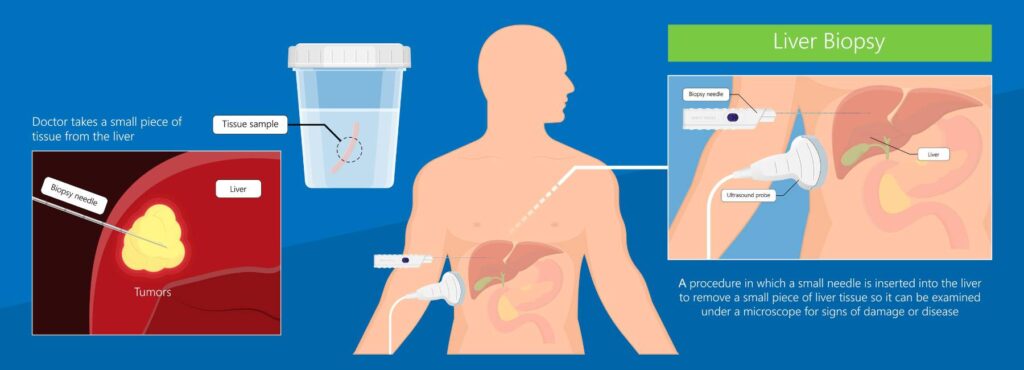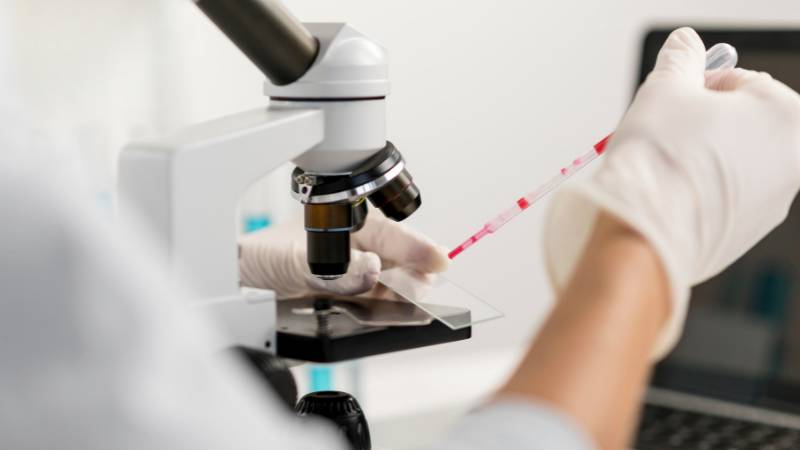A biopsy is getting a sample of worrisome area. A biopsy removes a piece of tissue that can be analyzed. In this way , if cancer or an infection are found, the patient can be treated at once.
Table of Contents
ToggleWhy are Biopsies Performed?
Biopsies are performed to get a diagnosis for a particular problem so that a treatment plan can be designed and implemented. Diagnoses are needed to find out:
- If a mass is cancer or not
- If a certain area is infected and what type of infection it is
- Why an organ is not functioning well (Eg kidneys, liver)
What Types of Biopsies are There?
There are many types of biopsies, depending on the area that is of concern.
The most common ones include:
- Open, surgical biopsy
- Laparoscopic, surgical biopsy
- Endoscopic biopsy
- Image-guided needle biopsy
- Bone marrow biopsy
- Skin biopsy

What Types of Needle Biopsies are Done?
A biopsy is usually an outpatient procedure. There are two different types: fine needle aspiration (FNA) and core needle biopsy (CNB). Either type involves taking tissue samples from different areas in your body that will be diagnosed as cancerous or noncancerous using either human or robotic technology. A FNA uses a thin hollow needle to remove cells from your breast mass; CNB removes a bigger core of tissue from your concerning mass. Both are usually outpatient procedures?
What Does an FNA Involve?
Fine Needle Aspiration (FNA) is a quick, painless, outpatient procedure lasting about 10-15 minutes where a tiny needle is inserted into the area to be biopsied to remove cells for examination under a microscope. Local anesthetic or numbing medicine is given and then a small needle inserted under image guidance into the area of concern. You will feel just a little pushing sensation as the needle goes into place. The doctor sees on a imaging monitor what he’s doing so there’s less chance of error – his hands don’t have to be inside you so there’s no chance for infection. The samples are sent to the lab where they can be analyzed.
What Does Core Needle Biopy Involve?
Core Needle Biopsy (CNB) is a quick, painless, outpatient procedure lasting about 10-15 minutes where a bigger needle is inserted into the area to be biopsied. Local anesthetic or numbing medicine is given and then a larger needle inserted under image guidance into the area of concern. You will feel just some intermittent pressure as the doctor guides what he sees on an imaging monitor inside your body so there’s less chance of error – his hands don’t have to be inside you so there’s no chance for infection. The samples are sent to the lab where they can be analyzed so you can get a diagnosis as quickly as possible.
Why Do We Need a Biopsy?
We need a biopsy to make sure of the diagnosis. It can determine or rule out a condition. We may also get a biopsy if we want to learn more about a condition and what it will mean for our future. Biopsies are also done when we have signs that no longer match the initial test results, such as hormone levels in someone with suspected endocrine disease or antibodies in someone with suspected autoimmune disease. In addition, some people choose to get a biopsy because they want to start treatment for their problem right away instead of waiting for further tests to come back from the lab, so going straight to a procedure might be better than waiting weeks or months until the next appointment.
What are Biopsies Used For?
When a concerning area like a lump or nodule is found in your body before treatment can start your doctors need to know exactly what it is. For this, they need a piece of this tissue. This tissue can be looked at under a microscope. Special methods can be used to determine the exact diagnosis. Sometimes special tests are performed to determine the best treatment – especially if the biopsy shows cancer.
The area of concern may be discovered by you: a breast lump, a lump in another part of you body. Or it may be discovered by imaging either looking specifically for it or incidentally while investigating something else. Biopsies can also be performed of a certain organ when lab results show there is something wrong: random renal and random liver biopsies for example. The sample taken can be analyzed and give a diagnosis and therefore guide treatment, if needed.
What are Some Common Biopsies?
- Parotid Biopsy: A parotid biopsy is a common biopsy. It is usually done to diagnose tumors or other problems in the salivary glands. A fine needle or small core of tissue is removed usually guided by ultrasound which is not an invasive procedure.
- Neck Biopsy: Another common biopsy is a neck or cervical biopsy often done for enlarged lymph nodes. A small sample of the lymph node is removed and sent to a lab for analysis. The biopsy is usually done under ultrasound guidance.
- Thyroid Biopsy: Thyroid nodules become more frequent as we age. Few are cancerous. So when you have a thyroid nodule your doctor may advise getting a biopsy. Because this can be done by ultrasound guidance it is less invasive than open surgery. Bone, lung, liver, kidney, soft tissue adrenal and splenic biopsies These are performed for a wide variety of reasons from getting a tissue diagnosis for a mass to understanding why organs are not performing well. Biopsies can be done using MRI, CT or fluoroscopic guidance and usually done to diagnose a tumor or infection in bone.
- Bone, Lung, Liver, Kidney, Soft Tissue Adrenal and Splenic Biopsies: These are performed for a wide variety of reasons from getting a tissue diagnosis for a mass to understanding why organs are not performing well. Biopsies can be done using MRI, CT or fluoroscopic guidance and usually done to diagnose a tumor or infection.
- Breast Biopsy & Aspiration: Breast biopsies are a common biopsy procedure. A small sample of cells is removed for analysis in the lab. There are different types of breast biopsies – One type uses an ultrasound machine to guide the needles into the breast tissue see images below. Aspiration is another and involves removing fluid from inside the lump in order to look at it in a microscope or test it in other ways. A stereotactic biopsy is where the area is pinpointed using 3D mammography, MRI or ultrasound and small samples are taken.
How are Biopsies Performed?
Biopsies range for open surgical procedures to non-surgical “PINHOLE” procedures (like those performed by Imaging & Interventional Specialists).
Open, surgical biopsies involve general anesthesia, a relatively large incision and recovery time in a hospital and are done in an operating room.
Laparoscopic “KEYHOLE” surgical biopsies involve multiple incisions, general anesthesia and recovery time in a hospital and are done in an operating room.
Endoscopic biopsies are usually performed by gastroenterologists where a long tube is passed either through you mouth or anus and sample collected. A polyp removal during a colonoscopy is an example.
What Do I Need to Do to Prepare for a Biopsy?
Most biopsies can be performed as outpatient procedures meaning you go home after the doctor has performed them. In some cases, patients may need to have a nurse or family member stay with them for a few hours after they return home from treatment.
In preparation for your biopsy, it is important that you follow your doctor’s instructions carefully. Many doctors ask their patients not to eat or drink anything the morning of or day before a procedure – others will allow clear liquids until midnight before an appointment.
Your doctor may want you to allow time to arrange a ride home after your biopsy – especially if general anesthesia is used. If you live alone, please make sure someone knows that you are having this procedure and how they can get in touch with you.
What are the Risks and Side Effects of Biopsies?
Surgical biopsy procedures carry certain risks, including bleeding, infection and anesthesia problems. As discussed above endoscopic biopsy procedures like colonoscopy tend to be well tolerated without major complications. The most common risk is that the tissue samples may not give the pathologist enough information for a diagnosis.
How Successful are Biopsies?
The accuracy of a biopsy depends on where it is taken from – its anatomical site or location, as well as individual patient factors (such as age, gender, general health). If your doctor doesn’t receive conclusive results from your sample, additional testing may be required. For example, a second biopsy may be needed from the same tissue type to confirm a diagnosis. Sometimes, repeated aspirations from a suspicious area may give your doctor enough material for testing. In other cases, cells or tissues from related organs such as lymph nodes or other sites in the body that show similar changes may need to be sent for testing to determine if there is a cancer present and its stage.
can be performed in an outpatient setting without being “put to sleep”
Why Imaging & Interventional Specialists?
Imaging & Interventional Specialists are leaders in interventional radiology and experts in the non-surgical procedures for biopsies.
Using state-of-the-art equipment, our experienced board-certified specialists provide exceptional biopsy services.

